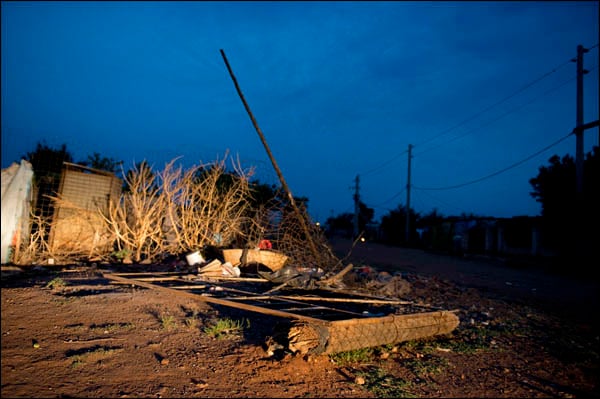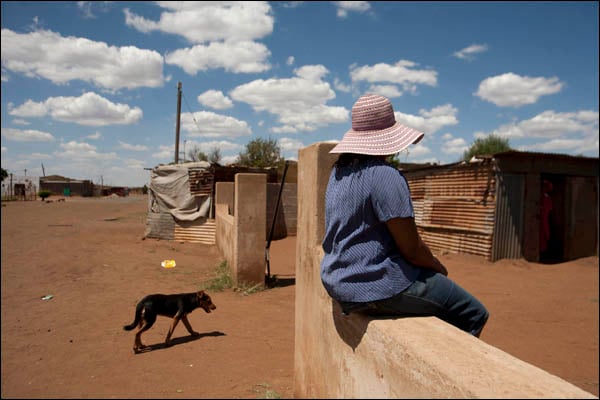A charred patch is all that remains after alleged gang members burned to death in the middle of a major intersection in Khutsong. (Paul Botes, M&G)
As the police convoy snakes away, the 43-year-old Khutsong mother of six takes out a pink cellphone she had tucked away in her bra.
A small group is huddling around her, shielding the sun's glare. The woman, who only wants to identify herself as a "concerned resident", wants to show a video she took on November 3.
Read more:
She wants the gathering to see that she was there when two of the six people were killed.
With the shadow from a cupped hand and the volume on the phone pumped up, she narrates the scene that unfolds.
Somewhere in the background, music is pumping and a crowd of people is swaying and dancing to its rhythm and they are clapping and cheering.
The video is 14 minutes long and records the horrific dousing in paraffin and incineration of two people accused of being gangsters. The hand holding the camera never shakes, only moving to wave with the pulse of the mob.
The woman is jubilant. The police just searched her and everyone in her street for evidence, but they did so with little enthusiasm.
"These creatures [gang members] went inside a church on a Sunday to rob people," she says. "They had no fear."
Charred bodies
She wants to share the video, but it is too big, so she points to another group standing in the shade of a nearby general dealer.
A member of that group, who only identifies himself as Michael – nobody shares their full name because of a fear of the police identifying them – eagerly takes out his phone. It has a better camera and he starts flipping through photographs of charred bodies.
 A 400-strong crowd broke down the gate leading to James Magugela’s yard, before dragging him out and setting him on fire. (Paul Botes, M&G)
A 400-strong crowd broke down the gate leading to James Magugela’s yard, before dragging him out and setting him on fire. (Paul Botes, M&G)Another group gathers to look at the pictures, and to share their experiences.
The woman says the gangs had become too violent and the community had had enough. She says she has been robbed twice by people wielding pangas and knives.
"The gangsters come to an area or to a shebeen with their pangas and force people to put everything on the ground. They take everything."
There are four large gangs split across Khutsong. Their members all wear masks and are aged between 14 and 23. In her area it is the Casanovas that are the problem – and they are the ones the community decided to kill on November 3.
Flying squad
In groups of more than 50, they are immune, she says.
"They deal drugs in our park and we have called the police. But when they come they say they are too afraid to chase them. So we had to do this for ourselves."
In radio interviews and press conferences right after the attack, the police condemned the vigilante action and said that with many of the criminals being under age it was hard to do anything to combat crime when they had to be released.
The woman's anger is reflected in the excited way people talk on the dusty side streets. The tarred roads are constantly patrolled by police cars from across the province – from Cullinan to Sandton.
Flying squad cars also drive down the claustrophobic side roads where the killings took place. But people say this is a rare thing and they are left to deal with crime on their own.
"The gangsters here took over. They had to be taught a lesson," says a stylishly dressed young man sitting in the shade with several friends.
Exaggerated swagger
He stands up and untucks his T-shirt before walking a few steps with an exaggerated swagger.
"This is how they were walking on Saturday."
He tucks in the shirt and walks upright.
"They have respect now."
The group breaks out in laughter.
With the community's muscles flexed, the gangs have gone quiet.
"The point has been made to the gangsters, so now things will return to normal. Khutsong is a good place, this isn't a Dobsonville, where there is always violence."
He leans back in his plastic chair with a smile on his face.
 A resident recorded the attack on her. (Paul Botes, M&G)
A resident recorded the attack on her. (Paul Botes, M&G)
Dissenting voices seem rare. A woman who lives near the burnt shack of one of the victims says her family and neighbours locked themselves in their homes when the mob came for "those innocent people".
But she is conflicted. "It is not safe here. The gangsters come when they want to your home and tell you to ‘sssh' while they take what they want. Nobody comes to help because we are all afraid, so you are on your own."
She has seen the pictures, but goes silent when they are mentioned.
"It is wrong to celebrate like this. These are our people."
Necklacing returns to haunt us
Necklacing is not a uniquely South African phenomenon – Brazilian gangs use it – but it is uncommon elsewhere. It began under apartheid as a way to kill informers in some communities who were working for the regime. This was supposed to put anyone off the idea of betraying their comrades again. It subsided, only happening sporadically after 1994. In 2008 it made a comeback with the xenophobic killings of foreign nationals.
Must-have pictures of death
Journalists become pretty blasé about extreme violence. You get used to it. Protests, deaths, lives in turmoil, desperation. It is the job.
But Khutsong was different. Here people were celebrating the public murder of people in their community. They were sharing the pictures with pride, and even tweeting and facebooking them.
As a journalist, I had to get the pictures. They are now on my phone, waiting for the paper to go to bed before I delete them. They will always be in my head. The necklacing achieved its shocking purpose.